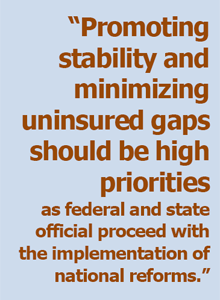Synopsis
Large numbers of Americans experience gaps in their health care coverage. Eighty-nine million people—36.3 percent of Americans ages 4 to 64—were uninsured for at least one month between 2004 and 2007, including 23 million Americans who lost coverage more than once. To minimize disruptions in people’s care and exposure to high costs, policymakers should consider steps to stabilize public and private coverage as they implement health reform.
The Issue
The Congressional Budget Office projects that the Affordable Care Act’s health insurance expansions will reduce the number of uninsured Americans in 2022 from 60 million to 30 million people. But such projections—which are based on data representing one point in time—may understate the number of people who would be uninsured without health care reform. This is because people often experience gaps in coverage resulting from changes in employment or family circumstances. For this Commonwealth Fund–supported study, researchers examined gaps or transitions in public or private coverage between 2004 and 2007. The analysis provides benchmark data from the period of relative economic prosperity before the 2008–09 recession to measure the effects of health reform on the stability of insurance coverage.
Key Findings
- Eighty-nine million people—36.3 percent of Americans ages 4 to 64—were uninsured for at least one month from 2004 to 2007. This included 12 million people who were continually uninsured, 11 million who were uninsured but gained coverage at some point, 11.5 million who were insured and then lost coverage, 14 million who experienced a single gap in coverage, and 6 million who had a temporary spell of coverage and were otherwise uninsured.
- Many people appeared to have had particularly unstable coverage: 23 million people—more than a quarter of those who were ever uninsured during the four years—lost health insurance more than once.
- Among those with family incomes below 200 percent of the federal poverty level (FPL), 64.2 percent of adults and 59.5 percent of children were uninsured for at least one month.
- Among children with family income under 200 percent of the FPL—the target population of the Children's Health Insurance Program (CHIP), which opened for enrollment in 1997—the uninsured rate dropped by 8 percentage points from 1996–99 to 2004–07.
- Children were less likely than adults to be uninsured throughout the four years (5.4% vs. 16.9%), but were more likely to have frequent changes in coverage sources, coverage gaps, or to transition out of coverage. About 88 percent of children who were repeatedly uninsured were covered at some point by Medicaid or CHIP.
Addressing the Problem
As federal and state policymakers implement health reform, they should consider taking steps to minimize disruptions in public or private coverage that put people at financial risk, affect continuity of care, and add to administrative costs. In particular, efforts should be made to stabilize coverage for low-income children enrolled in Medicaid or CHIP. States' efforts to standardize and coordinate the determination of eligibility for premium tax credits, Medicaid, and CHIP will also be important. 
About the Study
The analysis used data from the Survey of Income and Program Participation, which collects information from the same individuals every four months over a four-year period. The researchers examined changes in insurance coverage among those ages 4 to 64 from 2004 to 2007, which is the most recent period for which four-year data are available. The study updates the authors’ earlier analysis of coverage gaps from 1996 to 1999.
The Bottom Line
Large numbers of Americans continue to experience gaps in health coverage—even during times of economic growth. As policymakers implement health reform, they should take steps to stabilize coverage in both public and private health plans.


